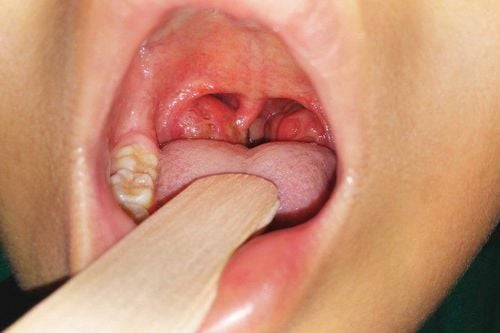This is an automatically translated article.
The article was consulted with Specialist Doctor Ear - Nose - Throat Doctor - Department of Medical Examination & Internal Medicine - Vinmec Ha Long International Hospital.
Tonsillectomy can cause fatal complications due to many different causes, such as anesthesia, improper cutting technique, patients with blood clotting disorders. Therefore, before tonsillectomy, the patient will be assigned to perform the necessary tests to ensure safety in surgery.
1. What cases need tonsillectomy surgery?
The tonsils are lymphatic tissues containing white blood cells, which are responsible for recognizing bacteria to produce antibodies to destroy bacteria when they invade. It, together with other lymphatic organs in the pharynx, forms the Waldayer lymphatic ring that surrounds the respiratory and gastrointestinal tracts.
When bacteria enter through the mouth, they will attach to the tonsils, then white blood cells will attack the bacteria and bring them inside to recognize and create antibodies, then the antibodies are multiplied and carried everywhere. , but mostly concentrated in the nasopharynx to fight bacteria when re-infected.
It is also because of this that the tonsils are very easily inflamed, this condition can recur many times, causing serious complications. In some cases, surgical removal of the tonsils is necessary. But not every tonsillitis needs to be removed.
Cases indicated for tonsillectomy include:
Tonsillitis with recurrent inflammation > 5 times/year and for at least 2 consecutive years. Tonsillitis causes complications. Overdose tonsils cause airway obstruction. Tumor suspected of malignancy requires histopathological examination.
2. Does tonsillectomy have dangerous complications?
Tonsillectomy can cause fatal complications due to many different causes such as: Anesthesia, improper cutting technique (when surgery damages blood vessels causing unstoppable bleeding), patients with coagulopathy blood.
That's why before tonsillectomy surgery, you need to do very careful tests on liver function, kidney function and blood clotting factors to avoid unfortunate complications. If indicated, you should have surgery at a hospital that specializes in otolaryngology.

3. Cut tonsils by what means?
There are many different devices used for tonsillectomy, the improvement of these devices is based on the criteria of good hemostasis and minimal burning of surrounding tissue.
The electric knife is a routine device in the operating room used for tonsillectomy. It has the advantage of being inexpensive, relatively good hemostasis, but the burn is high, the temperature at the cutting site can be up to 400 degrees Celsius, so the possibility of causing damage to surrounding tissue is large. After tonsillectomy, patients often experience more pain and a higher risk of secondary bleeding.
Laser surgery has the advantage of causing less tissue damage, but its ability to stop bleeding is limited and the surgery time is longer.
Plasma and coblator are means of good hemostasis and low degree of burn of surrounding tissue but high cost.
Ligasure knife has excellent hemostasis ability along with very low degree of tissue burn, quick surgery time (5-10 minutes), patient uses less anesthetic, thus reducing the risk of complications due to anesthesia, reducing the risk of complications. post-operative pain as well as minimizing the possibility of secondary bleeding.
4. How is tonsillectomy performed?
Before tonsillectomy, the patient will be sedated or sedated, and with each method of anesthesia, the patient will be in a different position.
With anesthetic tonsillectomy, the patient will sit for surgery, for children with an accompanying person. With endotracheal tonsillectomy, the patient lies on his or her back for surgery. 4.1. Tonsillectomy with Sluder-Ballanger Step 1: Anesthesia at the tonsil stalk, tonsil cavity (anaesthesia for dissection); can add anterior and posterior cylinders with 2% lidocaine or 2% xylocaine with adrenaline phase 1/100.000. Step 2: Expose the tonsil mass by opening the patient's mouth. Step 3: Insert the sluder ballenger instrument from the lower pole, the doctor presses the tool handle against the opposite lip edge to the side to be cut in a lever style. Instrument hole closes to tonsil mass. Step 4: Insert the tonsils into the instrument hole. The doctor will press the instrument hole into the tonsil block, and at the same time squeeze the opposite lip in a lever way to push all the tonsils into the instrument but not let both the anterior and posterior pillars. Step 5: Separate the tonsils from the cavity. The doctor uses his index finger to stroke the tip of the instrument to separate the mass and the tonsil fossa, and at the same time bring the instrument forward for complete dissection. Then, continue squeezing the tool so that the removed tonsil is still attached to the hole of the instrument. Avoid tonsils falling down the throat. Pull the cut tonsils out of the throat cavity. Avoiding tonsils from the pit is the most difficult movement, requiring good coordination of both hands. Step 6: Check and stop bleeding from the incision. The doctor used a curved forceps to force a cotton swab to press on the incision for a few minutes to stop the bleeding. Then, the doctor will check the incision with the abutment, if there is arterial bleeding, clamp and stop the bleeding. 4.2. Tonsillectomy by method of nose dissection (Tyding or Vacher) Stage 1: Anesthesia at the tonsil peduncle, tonsil cavity (anaesthesia for dissection); can add anterior and posterior cylinders with 2% xylocaine or 2% lidocaine with adrenaline 1/100.000. Stage 2: Separation of the upper tonsil pole by using alice to clamp near the upper tonsil pole gently pull inward, take a knife and make a slight incision of the anterior ulnar mucosa, about 2mm from the free edge. Then gently dissect the mucosa to the tonsil capsule, then continue dissection to the upper pole. In the upper pole there are several arteries that bleed easily. Stage 3: Dissection of tonsil block. Separate the anterior pillar from the tonsil, then separate the posterior wall, then separate the posterior pillar to the lower pole of the tonsil, then the tonsils are only attached to the pedicle incision. Then 4: Cut the lower pole with the noose. The doctor uses an alice to clamp the tonsils through the noose, bring the end of the noose close to the lower pole, then tighten the handle of the noose slowly until the lower pole is severed. Then remove the tonsils. Then 5: Check and stop bleeding in the surgical hole. The doctor used a curved forceps to force a cotton swab into the incision to stop the bleeding for a few minutes. After that, remove the forceps and examine the incision with the abutment to see if there is still bleeding? If arterial bleeding persists, clamp and tie or cauterize the bleeding. After hemostasis is completed, the surgical side is stable, then the tonsils on the opposite side can be removed. Endotracheal anesthesia tonsillectomy: After anesthesia, the doctor can remove the tonsils with a noose, unipolar, bipolar knife, Microdebrider, Coblator or ultrasound knife, plasma knife...
The steps are similar. Similar to tonsillectomy by dissection method above. The tonsillectomy techniques can be cut with a unipolar, bipolar, noose, coblator... Careful hemostasis is needed to ensure that the two tonsils are dry well.

5. Problems patients need to pay attention to after tonsillectomy surgery
Pain: After the tonsillectomy, on the 2nd day you may have more pain than the first day, because on the first day of intravenous pain medication, the analgesic effect is better. And from the 2nd day on, you will be given oral pain relievers, so the pain is more painful but tolerable, usually after 5-7 days it will be more comfortable. Sputum entanglement: After tonsillectomy, sputum will increase and accumulate in the 2 tonsils, and because of pain, you do not swallow much saliva, increasing sputum secretion, causing discomfort in the throat. However, you are not allowed to spit, not to clear your throat... Bleeding is likely to happen if you spit or clear your throat a lot. Cough: You need to try to control the cough because coughing a lot is easy to bleed, doctors often prescribe more cough medicine for you. If you still have a lot of cough, contact your doctor for appropriate treatment. Eating and drinking: You need to absolutely abstain from eating hard, hot, sour, spicy foods, abstain from alcohol and tobacco. The first day after surgery, you should only drink milk or eat cold porridge. On the 2nd and 3rd day after surgery, you can eat cold soup, cold milk or diluted porridge. From the 4th to the 14th day, you can eat porridge, vermicelli, pho and soft food... By the 15th day, you can eat rice normally. Bleeding: After a tonsillectomy, you may experience some bleeding for the first 15 days, due to the shedding of the pseudomembranous layer causing bleeding. During the 5th - 10th day, if there is a small amount of bleeding and it stops on its own after about 5-10 minutes, it is not a cause for concern and does not need to go to the hospital. But if the bleeding is profuse and does not stop on its own, the bleeding persists, you must go to the hospital urgently for timely treatment by a doctor. Incision: Usually, the incision will heal completely after 3 weeks. However, the healing rate depends on each person, nutritional problems, infections... Ability to speak and work: After tonsillectomy, you don't need to abstain from speaking completely, just don't speak loudly. talk a lot, you can speak softly. You can do light activities 10 days after surgery, but you should not do heavy or vigorous activities for at least 2 weeks after surgery. Re-examination: You need to have a follow-up visit on the right day so that the surgeon can check and evaluate the condition after surgery. In summary, tonsillectomy can cause fatal complications due to many different causes, such as anesthesia, improper cutting technique, patients with coagulation disorders. Therefore, patients should choose a reputable medical facility to perform surgery.
Currently, Vinmec International General Hospital has been regularly applying the method of tonsillectomy and VA using the Coblator system, with a team of good and experienced ENT doctors and equipment systems. Modern facilities will be the perfect choice for patients.
Please dial HOTLINE for more information or register for an appointment HERE. Download MyVinmec app to make appointments faster and to manage your bookings easily.













